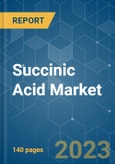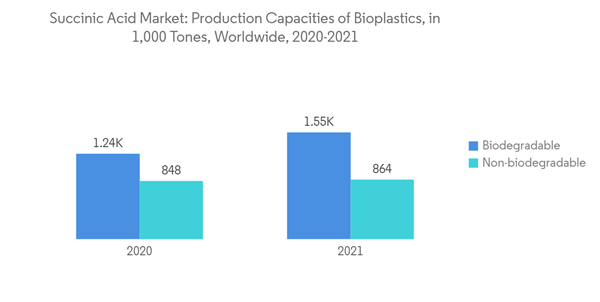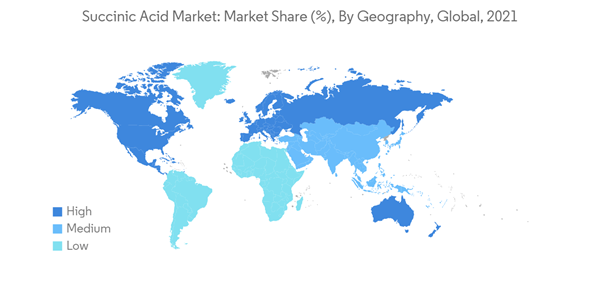The succinic acid market is projected to witness a CAGR of 7.2% during the forecast period.
This product will be delivered within 2 business days.
Key Highlights
- Succinic acid is a typical organic acid that can be used as a precursor to creating a variety of chemicals, including solvents, fragrances, lacquers, plasticizers, dyes, and photographic chemicals in the food, chemical, and pharmaceutical sectors. Aside from being an antibiotic, succinic acid is also a treatment.
- Succinic acid can be used as an acidifier and taste enhancer in food like relishes, beverages, and sausages. The potential use of succinic acid as starting feedstock for the production of industrial chemicals and consumer products with large markets was the main driver that launched the development of technology for bio-based succinic acid production.
- Due to its wide range of applications in various chemical processes, this product's applications go beyond just items and extend to include the human body. By administering the acid to the skin, joint and arthritis pain can be relieved. It greatly aids in fading any skin scars and lessens the effects of aging. Finding alternatives to hazardous chemicals for the environment and human health has become more important due to growing public concern.
- Numerous additional compounds are used in the manufacture of succinic acid. It consequently has a negative impact on the immediate area as well as the environment as a whole. The demand for acid replacements increased as a result. Bio-succinic acid is one such replacement. Climate change is lessened by bio-succinic acid synthesis. Using waste streams, the acid that replaces the use of petrochemicals ensures a clean environment. Many substances that have the potential to harm the environment are thought to be suitable replacements for bio-succinic acid.
Succinic Acid Market Trends
Increase in Demand for a Bioplastics Using Succinic Acid
- Succinic acid derived from carbohydrates is gaining more acknowledgment as a renewable biochemical for producing various sustainable value-added goods, including bio-plastics. A bioplastic alternative to petroleum-based synthetic polymers like polyethylene and polypropylene is polybutylene succinate (PBS).
- The global bioplastics production capacity is expected to rise from roughly 2.42 million tonnes in 2021 to roughly 7.59 million tonnes in 2026, according to the most recent market data provided by European Bioplastics in partnership with the nova-Institute. As a result, the proportion of bioplastics in the world's plastic output will surpass the two percent level for the first time.
- Bioplastics are being used in various industries, including packaging, food service, consumer electronics, automotive, agriculture/horticulture, toys, and several other sectors. According to European Bioplastics, with 48% (1.15 million tonnes) of the global market for bioplastics in 2021, packaging will continue to be the leading market category for these materials.
- The variety of applications in the portfolio is still growing, though. Due to the expanding capabilities of functional polymers, certain industries, like automotive and transportation or building and construction, continue to grow, creating opportunities for the succinic acid market across the globe.
Asia-Pacific is the Fastest-Growing Market
- The succinic acid market is segmented into North America, South America, Asia-Pacific, Europe, the Middle East, and Africa. A significant development in application drives the market in the Asia-Pacific region. Moreover, the availability of low-cost labor is boosting production plants in Asia-Pacific, with China holding the highest production capacity among all the other countries in the region.
- Europe is the leading revenue-generating market for succinic acid, mainly due to the strict regulatory imposition on using certain hazardous chemicals that threaten the environment and human beings. A substantial potential opportunity exists for bio-based succinic acid due to the region's strict environmental rules and the fact that industries play a significant role in the development of any economy. It is well known to be a crucial ingredient used in the production of more than 30 goods used for industrial and commercial reasons. Hence, manufacturers are shifting to greener substitutes (bio-succinic acid) to comply with the requirements.
- Additionally, according to a report published by PlasticsEurope (PEMRG) in 2022, the European Union (EU 27), Norway, Switzerland, and the United Kingdom collected an estimated 29.5 million metric tons of consumer plastic garbage from posters. 35% of this total was recycled. Most post-consumer treatments comprised energy recovery, with landfilling making up nearly a quarter. Such problems have created opportunities for the succinic acid market as it is used to manufacture bioplastics.
Succinic Acid Market Competitor Analysis
A diversified product portfolio, high depth in application reach, and technical assistance to customers are the factors responsible for strengthening the position of these companies in the succinic acid market. The players in the market have also been adopting various organic and inorganic growth strategies, such as partnership, agreement, and expansion, to enhance their current position in the succinic acid market. Major succinic acid market players include PTT Public Company Limited (Myriant), Reverdia, Corbion N.V., BASF DE, and Mitsubishi Chemical Corporation.Additional benefits of purchasing the report:
- The market estimate (ME) sheet in Excel format
- 3 months of analyst support
This product will be delivered within 2 business days.
Table of Contents
1 INTRODUCTION
4 MARKET DYNAMICS
5 MARKET SEGMENTATION
6 COMPETITIVE LANDSCAPE
Companies Mentioned (Partial List)
A selection of companies mentioned in this report includes, but is not limited to:
- BASF SE
- Myriant
- Succinity Gmbh
- Reverdia
- Nippon Shokubai
- Mitsubishi Chemical Corporation
- Kawasaki Kasei Chemicals Ltd
- Linyi Lixing Chemical Co. Ltd
- Anhui Sunsing Chemicals
- Gadiv Petrochemical Industries Ltd
- Corbion N.V.
Methodology

LOADING...










